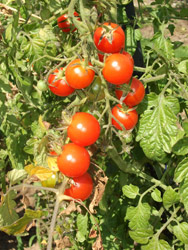Be creative with space for vegetable gardens
Chronicle Media — May 19, 2018
Vegetable gardeners in urban areas or in smaller living spaces should consider growing vegetables in containers. (Photo courtesy of U of Illinois Extension)
Most people grow vegetables in traditional gardens in rows. Large gardens can seem overwhelming, especially during the heat of summer or after a vacation. If you don’t have space for that or just want to try something different, here are some other options to try.
A larger garden is needed for certain crops such as sweet corn. Still, you do not have to plant the garden in a traditional design of long rows. Gardens can be designed in interesting ways and include flowers and vegetables for more visual effect.
One trend right now is growing vegetables in raised beds and containers. Container vegetable gardens are particularly popular with gardeners who have little or no ground space. Containers may be located almost anywhere and can be both decorative and harvestable.
Popular choices for container gardens include attractive pots of kitchen herbs, hanging baskets of ripe red tomatoes, and window boxes of bright leaf lettuce or fresh radishes. Dwarf vegetable varieties work particularly well in containers.
If you don’t have a container, you can garden right in the potting mix bags. Purchase potting soil bags at your local nursery or garden center, and cut a few drainage holes in the back side of each bag.
Lay the bags flat on the ground, and then cut holes in the top of the bags to make room for the plants. Use a hose to moisten the potting mix, and then add plants. This makes a quick and easy vegetable garden.
For those with extremely limited space, a vertical garden might be the way to go. Vining crops work especially well when trellised up a wall.
Other options include bean poles, teepees covered in vines, may poles, or even tomato cages. Vegetables to try including peas, pole beans, squash, melons, cucumbers, pumpkins, and some tomatoes.
When choosing the structure, make sure that it is strong enough to support whatever will grow on it. Plants loaded down with fruit can become quite heavy. In some situations, dwarf varieties might work better.
Gardening in straw bales is a revolutionary concept to some home gardeners. Some feel that it solves every impediment today’s home gardeners face: bad soil, weeds, a short growing season, watering problems, limited gardening space, and even physical difficulty working on ground level.
Learn more about straw bale gardening from Kelly Allsup, University of Illinois Extension Horticulture Educator, in her University of Illinois Extension Four Seasons Garden webinar on YouTube at go.illinois.edu/4seasons_webinars.








